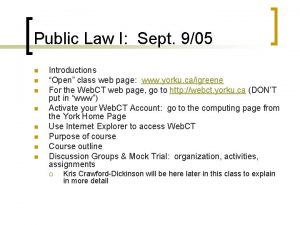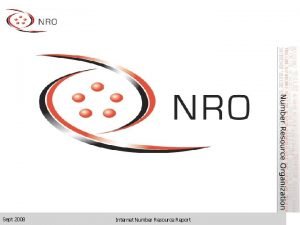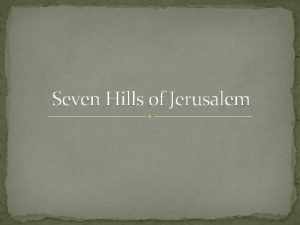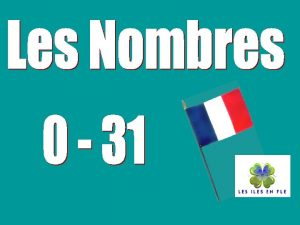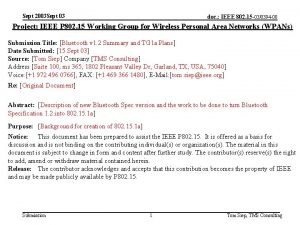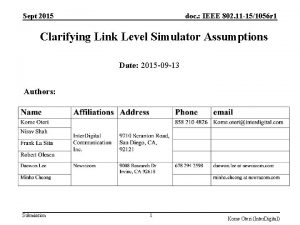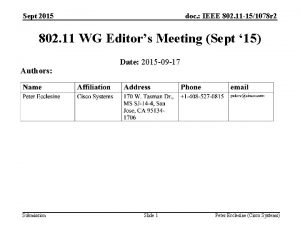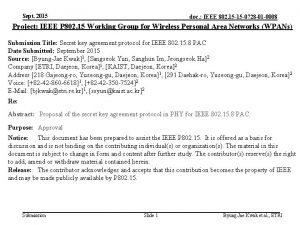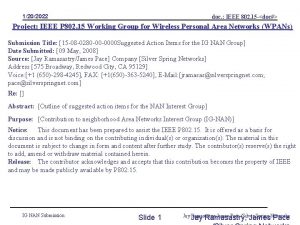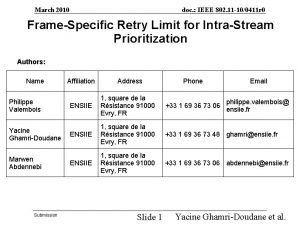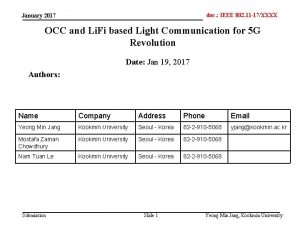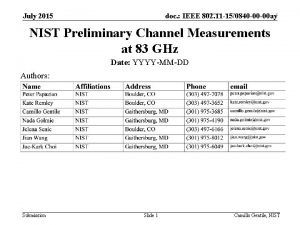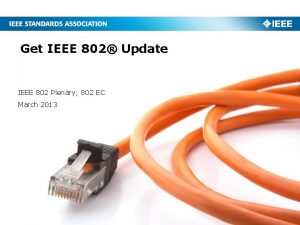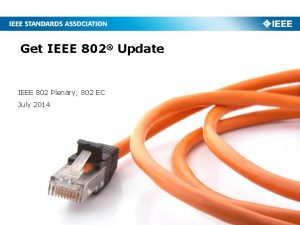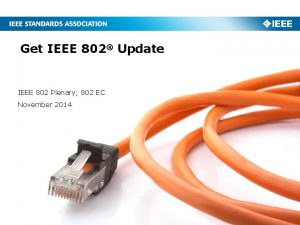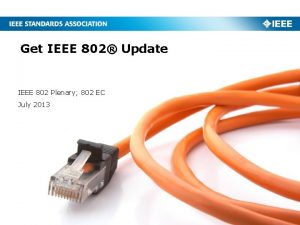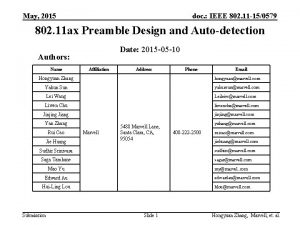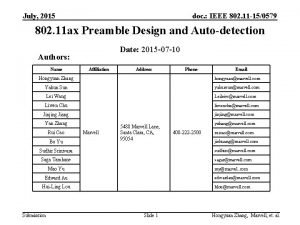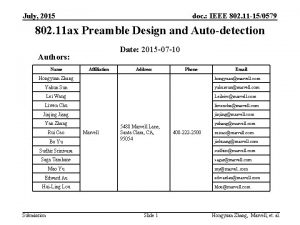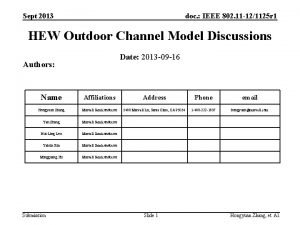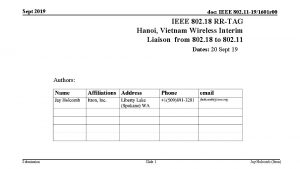Sept 2015 doc IEEE 802 11 151057 r
























- Slides: 24

Sept 2015 doc. : IEEE 802. 11 -15/1057 r 0 Multiple Resource Unit Allocation for TGax OFDMA Date: 2015 -09 -12 Authors: Submission Slide 1 Kome Oteri (Inter. Digital)

Sept 2015 doc. : IEEE 802. 11 -15/1057 r 0 Outline • • • Motivation Existing design and open questions System Level Simulation assumptions and results Link Level Simulation assumptions and results Conclusion Submission Slide 2 Kome Oteri (Inter. Digital)

Sept 2015 doc. : IEEE 802. 11 -15/1057 r 0 Motivation • Show potential benefits of multiple RU allocation over single user allocation via system simulations. – Identify need for updated interleaver design to enable multiple RU allocation • Show potential benefits of non-contiguous multiple RU allocation over contiguous multiple RU allocations via system and link level simulations Submission Slide 3 Kome Oteri (Inter. Digital)

Sept 2015 doc. : IEEE 802. 11 -15/1057 r 0 Existing Design • OFDMA Numerology and Structure [1] – PHY #10: Define 20 MHz, 40 MHz, 80 MHz, 160 MHz / 80 MHz + 80 MHz OFDMA building blocks Numerology for 20 MHz • Interleaver and Tone Mapper for OFDMA [2] – PHY #33: The BCC interleaver and LDPC tone mapper parameters to be defined in the table below Submission BCC Interleaver and LDPC Tone Mapper Slide 4 Kome Oteri (Inter. Digital)

Sept 2015 doc. : IEEE 802. 11 -15/1057 r 0 Open Questions • Q: Should we allocate more than one RU per user ? • Q: If multiple RUs can be allocated per user, how does this affect the interleaver design? – Observation: current design does not take all multiple RU allocation scenarios into consideration e. g. 3 x 26 -tone RU allocation • Q: If multiple RUs per user are allocated, should those RUs be contiguous or non-contiguous ? – DL OFDMA Signalling [3] • SP 1: Do you think we should be able to express non-contiguous RU allocation? Y: N: A = 46: 22: 54 Submission Slide 5 Kome Oteri (Inter. Digital)

Sept 2015 doc. : IEEE 802. 11 -15/1057 r 0 Study Outline • Study system throughput performance in SS 1 and SS 3 for – Single RU allocation – Multiple RU allocation : contiguous – Multiple RU allocation : non-contiguous • Study link level performance for MCS 7 in Channel D – Multiple RU allocation : contiguous – Multiple RU allocation : non-contiguous Submission Slide 6 Kome Oteri (Inter. Digital)

Sept 2015 doc. : IEEE 802. 11 -15/1057 r 0 System Throughput Simulation Assumptions • No MAC protocol overhead assumed • STAs are located based on specific TGax simulation scenarios [4] 20 MHz 80 MHz Table derived from [8] Submission Slide 7 Kome Oteri (Inter. Digital)

Sept 2015 doc. : IEEE 802. 11 -15/1057 r 0 Scheduler (20 MHz) 20 MHz Numerology Resource allocation for single RU allocation Resource allocation for Contiguous Case Resource Allocation for Non-contiguous Case Submission Slide 8 Kome Oteri (Inter. Digital)

Sept 2015 doc. : IEEE 802. 11 -15/1057 r 0 bps 20 MHz Results (System Simulations) Legend s. RU: Single RU Allocation C: Multiple RU Contiguous Allocation NC: Multiple RU Non-contiguous Allocation Performance gains for multiple RU non-contiguous allocation over single RU and multiple RU contiguous allocation can be observed Submission Slide 9 Kome Oteri (Inter. Digital)

Sept 2015 doc. : IEEE 802. 11 -15/1057 r 0 bps 80 MHz Results (System Simulations) Legend s. RU: Single RU Allocation C: Multiple RU Contiguous Allocation NC: Multiple RU Non-contiguous Allocation Larger gains for multiple RU non-contiguous allocation over single RU and multiple RU contiguous allocation over larger bandwidth can be observed Submission Slide 10 Kome Oteri (Inter. Digital)

Sept 2015 doc. : IEEE 802. 11 -15/1057 r 0 Link Level Simulation Assumptions Submission Slide 11 Kome Oteri (Inter. Digital)

Sept 2015 doc. : IEEE 802. 11 -15/1057 r 0 Link Level Contiguous/Non-Contiguous Allocation Gains observed for non-contiguous over contiguous at the link level Submission Slide 12 Kome Oteri (Inter. Digital)

Sept 2015 doc. : IEEE 802. 11 -15/1057 r 0 Multiple RU Interleaving • Q: How do we perform interleaving in multiple RU allocation ? – Reuse design in [2] with a multiplexer (S/P) and de-multiplexer (P/S) Submission Slide 13 Kome Oteri (Inter. Digital)

Sept 2015 doc. : IEEE 802. 11 -15/1057 r 0 Conclusions • Multiple RU allocation shows benefits over single RU allocation in some system level simulation scenarios (SS 3) • Non-contiguous multiple RU allocation shows benefits over contiguous multiple RU allocation • The interleaver design should be updated to allow for multiple RU allocation Submission Slide 14 Kome Oteri (Inter. Digital)

Sept 2015 doc. : IEEE 802. 11 -15/1057 r 0 Straw Poll #1 Do you agree to add to the TG Specification Framework? • The amendment shall allow multiple RUs to be allocated to a single user • Y/N/A Submission Slide 15 Kome Oteri (Inter. Digital)

Sept 2015 doc. : IEEE 802. 11 -15/1057 r 0 Straw Poll #2 Do you agree with the following? • The design of the interleaver shall be updated to allow for multiple RU allocations that are not captured in the current interleaver design • Y/N/A Submission Slide 16 Kome Oteri (Inter. Digital)

Sept 2015 doc. : IEEE 802. 11 -15/1057 r 0 Straw Poll #3 Do you agree to add to the TG Specification Framework? • The amendment shall allow for non-contiguous allocation of multiple RUs to a single user • Y/N/A Submission Slide 17 Kome Oteri (Inter. Digital)

Sept 2015 doc. : IEEE 802. 11 -15/1057 r 0 References 1. 2. 3. 4. 5. 11 -15 -0330 -05 -00 ax-ofdma-numerology-and-structure. pptx 11 -15 -0816 -00 -00 ax-interleaver-and-tone-mapper-for-ofdma. pptx 11 -15 -0854 -02 -00 ax-dl-ofdma-signalling. pptx 11 -14 -0980 -14 -00 ax-simulation-scenarios. docx 11 -14 -0882 -04 -00 ax-tgax-channel-model-document. docx Submission Slide 18 Kome Oteri (Inter. Digital)

Sept 2015 doc. : IEEE 802. 11 -15/1057 r 0 Additional Material Submission Slide 19 Kome Oteri (Inter. Digital)

Sept 2015 doc. : IEEE 802. 11 -15/1057 r 0 Granularity Definition @ Receiver: Instantaneous rates on the sub-channels (based on feedback granularity (FG)) are calculated and fed back to the transmitter. @ Transmitter: Instantaneous rates on the RUs (based on RU granularity (RG)) are calculated for each station and proportional fair scheduling is performed. Other users may use different granularity. Submission Slide 20 Kome Oteri (Inter. Digital)

Sept 2015 doc. : IEEE 802. 11 -15/1057 r 0 Gain Definitions %28. 5 %29. 5 %1. 9 Ref: C Ref: R NC: Non-contiguous allocation Submission C: Contiguous allocation Slide 21 R: Random allocation Kome Oteri (Inter. Digital)

Sept 2015 doc. : IEEE 802. 11 -15/1057 r 0 SISO Result Details NC: Non-contiguous allocation Submission C: Contiguous allocation Slide 22 R: Random allocation Kome Oteri (Inter. Digital)

Sept 2015 doc. : IEEE 802. 11 -15/1057 r 0 MIMO Result Details NC: Non-contiguous allocation Submission C: Contiguous allocation Slide 23 R: Random allocation Kome Oteri (Inter. Digital)

Sept 2015 doc. : IEEE 802. 11 -15/1057 r 0 Simulation Methodology of System Throughput • Obtain per tone SINR of STAs based on path loss and shadowing of specific simulation scenario [12] and fading channel [2] • Estimate effective SINR of sub-channels based on the specific numerology using the capacity mapping in [11] at the receiver • Send these to the transmitter using the desired FG • Perform proportional fair scheduling at the transmitter based on effective SINR of different sub-channels at the desired RG [9] • Assign users to sub-channels • Estimate PHY layer system throughput based on capacity of chosen users • Average over multiple drops Submission Slide 24 Kome Oteri (Inter. Digital)
 Bridges from 802.x to 802.y
Bridges from 802.x to 802.y Bridges from 802.x to 802.y
Bridges from 802.x to 802.y Ieee 802 family
Ieee 802 family Ieee 802 3 compliance
Ieee 802 3 compliance Ieee 802
Ieee 802 Arquitetura ieee 802
Arquitetura ieee 802 Estandar ieee 802
Estandar ieee 802 Ieee 802 standard
Ieee 802 standard Bluetooth ieee 802
Bluetooth ieee 802 802 ieee
802 ieee Ieee 802
Ieee 802 I sept
I sept Ecrivez les sept jours de la semaine
Ecrivez les sept jours de la semaine Accu poole sept
Accu poole sept Deportes
Deportes Sept comme setteur questionnaire
Sept comme setteur questionnaire Sept commandements
Sept commandements What does the prefix sept mean
What does the prefix sept mean La guerre de sept ans
La guerre de sept ans Cnn 10 2018
Cnn 10 2018 Sept
Sept Poésie l'embouteillage
Poésie l'embouteillage 7 hills of jerusalem
7 hills of jerusalem Sept heure moins le quart
Sept heure moins le quart Un deux trois quatre cinq six sept
Un deux trois quatre cinq six sept











